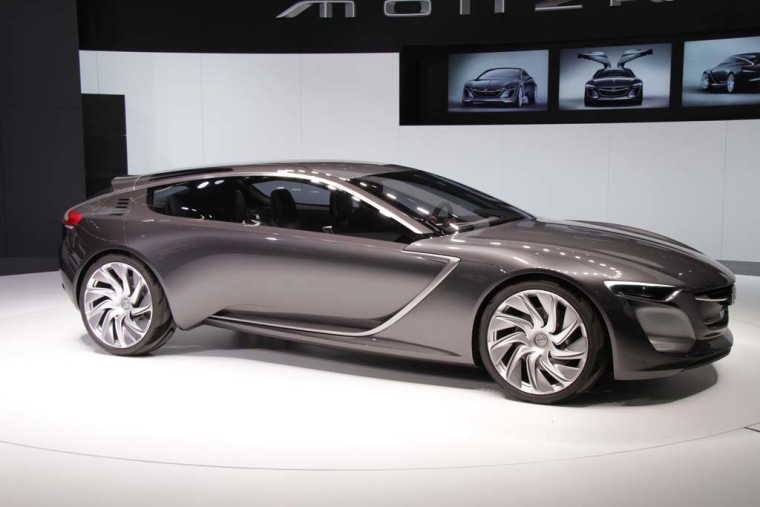As the Infiniti Q30 concept car rolled onto the stage this week during the Frankfurt Motor Show media preview, design chief Alfonso Albaisa noticed puzzled expressions throughout the audience.
“It defies characterization,” Albaisa said, suggesting that the Q30 might best be thought of as “not a coupe, not a hatch and not a crossover but a fusion of the three body styles.”
Read more: Complete Round-Up from the Frankfurt Motor Show
During the two days of Frankfurt press previews, Infiniti wasn’t the only automaker to roll out a design that didn’t fall into any easy or traditional category. There was also the Opel Monza which might alternatively be described, depending upon your viewing angle, as a wagon, sedan, coupe or even a sports car. For lack of a better definition, designer Mark Adams said he’s settled on the British-style “Sporting Brake.”
“What is that?” was a phrase one heard quite frequently during the Frankfurt Motor Show media preview. But that’s just fine with manufacturers like Infiniti and Opel who, in a hotly competitive automotive market, sense their biggest opportunities come not from trying to be the newest player in an established market segment – say, midsize sedans or compact utility vehicles – but to strike out and find what industry planners like to call “white space.”
Read more: Volvo Gets Voluptuous with Concept Coupe
Ford Motor Co., for example, uses a planning tool it has dubbed the “chess board” to try to isolate new opportunities as it prepares to roll out 25 all-new or completely redesigned products for the European market between now and late 2017. In some cases, the approach leads it to do a more up-market offering of a conventional product, such as the new Ford Mondeo Vignale revealed in Frankfurt.
Also new is the latest version of the Ford S-Max. Not quite wagon, not quite minivan, it has been one of the maker’s most successful products in Europe in recent years.
Read more: VW Goes Electric
“I’m surprised others haven’t come after us,” said Ford’s global design director J Mays, during a conversation about Ford strategy. Perhaps that’s because competitors are hoping to be equally creative with their response.
Getting creative with product segments isn’t an entirely new concept. Automotive pioneer Henry Ford scored a hit when he bolted a cargo bed on the back of his original Model T, creating the world’s first pickup truck nearly a century ago.
Read more: Toyota Gets it Wrong, Orders Re-Recall
And, indeed, one of the fastest-growing global market segments is itself an offshoot of a more established niche. In the 1990s, several manufacturers decided to put sport-utility vehicle-style bodies on top of passenger car platforms, rather than using the traditional, body-on-frame truck chassis. The crossover was born.
Crossovers quickly gained a following because they offered the best of both worlds: The higher seating position and – quite often – the all-wheel-drive capability of a truck-based SUV, while gaining the improved handling and better mileage of a passenger car.
Read more: BMW Reveals New Plug-in Sports Car
The push for more creative design has accelerated as manufacturers rapidly expand their product portfolios. There was a time when Mercedes-Benz could list its lineup on a single hand with models such as the C-, E- and S-Class, and the SL roadster. Today, it offers an alphanumeric soup of models including the CL, the GL, the CLS, CLK and SLK, as well as the new GLA, another hard-to-categorize entry also debuting in Frankfurt.
As the German auto show opens its doors to the public, motorists will find makers breaking the traditional rules just about anywhere they look. Jaguar, for example, rolled out the C-X17 concept – a crossover, for lack of a better term – that was one of Frankfurt’s biggest surprises.
“You don’t have to go back very far to see when manufacturers had little niches carved out and weren’t supposed to go anywhere else,” said Jaguar’s advanced design director Julian Thompson. “But things have changed and people are shifting all over the place.”
The ultimate reason for that shift? While manufacturers might prefer to follow set parameters, consumers don’t really care about definitions, added Thompson. “They just want what suits them.”
If it’s something that looks a bit like a wagon blended with a sports car that has the go-anywhere capabilities of an SUV, well, that might just be what some customers are looking for – or so makers like Opel, Infiniti, Ford and Mercedes are hoping.
